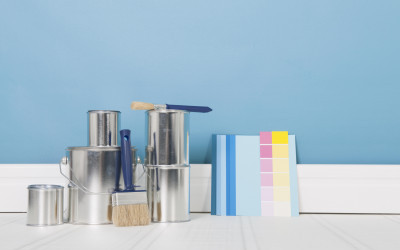Are you planning to paint the inside of your home?
With an array of palettes to choose from, finding the right interior paint colors is not always as simple as it seems. There are nuances to color selection, and your home also has its own unique style and set of needs. The right color combination should always enhance a room by improving its functionality, setting the mood, and adding more light and space.
If interior painting is on your summer home improvement list, here’s a breakdown on how to choose the perfect paint colors!
What’s Your Style?
You may already have an idea of some go-to colors that fall within your interior design scheme. For example, neutral colors and beiges are often seen in contemporary interiors where elegant furnishings, linens, decor pieces, and wood paneling are the focal points of a room. White and soft gray, which add a clean and spacious aesthetic, are staple colors in minimalist and modern homes. Smokier grays, browns, and deep reds lend more to industrial or rustic styles. Earth tones serve Mediterranean-style rooms that have ornate room features and tall ceilings. Softer, pale pastels are more suited to country, shabby-chic styles, and the list goes on…
What’s your interior design style?
Now is the time to find your personal home style if you’re planning to do major interior designing and decorating. Once you have a style in mind, you’ll have a better idea of interior paint colors going forward.
Set the Mood & Know Your Objective
Before you begin shopping around for paint colors, establish a few goals.
First, understand the purpose of the room you plan to paint. Is it a place where people gather and socialize? What types of activities go on in the room? Knowing the purpose of the room can help you decide the mood you want to set.
While you may feel inclined to paint a room in your favorite colors, remember that functionality is key. Take a look around and see what the room needs. Does it feel small and cramped? Does it have small windows and lack natural light? Lighter colors will open a room up and reflect more light. If you’re working with taller walls and an expansive ceiling where more light might not be necessary, painting a wall in a rich accent color will add depth and definition.
Find a Palette from the Color Wheel
Once you’ve laid down your home’s overarching style and scheme, it’s time to choose the right interior paint color palette. A palette refers to the specific colors you’ll use, and it should include colors for your main walls, accent walls, trims, and ceilings.
Before purchasing paint, make sure the colors you’ve chosen pair well with your furniture and decor. New color in a room creates the opportunity to rearrange, remove items, and replace them with new home goods.
A room should have a dominant color. Adjacent colors create a softer and more harmonious look, while opposing colors can have a more vivid or saturating effect. Use a color wheel to help you better understand the relationship between complementary and opposing colors and the mood they can invoke.
Color Ideas
For example, a blue room with paler blue-green accents can create a calmer overall feel to a room. Meanwhile, a yellow room can go from soft to vibrant with pale or dusty purple accent walls or trims. Here are some other interesting palettes that may work in your home:
- Coral, spring green, & pale blue-green
- Shadowy gray, stone blue, & brown
- White, icy blue, & light gray
- Indigo, gray, & dusty pink
Keep in mind that the more colors you try to incorporate in a room, the more challenging it can be to create harmony between them - but it is possible when the colors are dispersed appropriately as accent walls and trims.
Understanding How to Choose Interior Paint Colors
While painting itself can be a laborious task, the end result of a newly-painted room should be something every homeowner looks forward to.
Get inspired & find the right interior paint colors for your brand new home!
Share this Post
